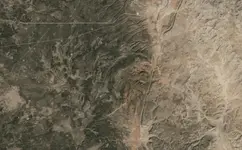Red_desert
Gold Member
- Joined
- Feb 21, 2008
- Messages
- 7,144
- Reaction score
- 3,786
- Golden Thread
- 0
- Location
- Midwest USA
- Detector(s) used
- Garrett Ace 250/GTA 1,000; Fisher Gold Bug-2; Gemini-3; Unique Design L-Rods
- Primary Interest:
- All Treasure Hunting
- #1
Thread Owner
Updating info on an older thread from last winter, posted by a retired PH D sciientist.
http://www.treasurenet.com/forums/d...olor-satellite-image-map-lad-placer-gold.html
Adams made the following remark a number of times (it appeared in a number of different versions of the stories) "No geologists will ever find my gold". BLM contracted with three different geology firms between 1960 and 1985 to check the area for valuable mineralization and all three reports came back negative. Back then they didn't have satellite mineral imaging.
This is the NW flowing canyon with the short pine trees, 1000' wide canyon with nothing growing in it, the springs flowing on the SE side of it and the SE side of this canyon is darker than the other
side of the canyon, and this canyon ends in a steep box canyon three miles
to the NW.
According to Adams the ridge above the gold was 15 miles long (this
alteration zone is that length). This was the only Alteration zone within 30 miles of
the Aspen stand, so he thought this had to be the place.
The alteration zone is around 15 miles long and the pinkish-purple
erosion areas range from 1/2 mile (near the bottom of the map) to a couple of miles
wide near the canyon at the top.
At the top of these two areas is the canyon where the water flows in a NW direction. The springs are located at its right end (near where the orange line and red lines cross/touch). Near the top of the black box area is a black circle. This is where he found two old home sites and the older one had been burnt down. The newer one dated to the early 1900s. The rock chimney is there as well.
This stone chimney should be within 1/4 from the placer site. The rock chimney was built near the side of the canyon up from the sandy area so they didn't have to worry about water.
There could be a cache (of these placers) under an old rock chimney, they did put about 100% of it there just before the Indians killed all of them. But It should be expected that possibly the cache under the chimney has already been taken by one of the three survivors (he went to Mexico and bought a big ranch there).
The placer gold should be very shallow. Most of the gold the Adams party dug was less than two feet deep. It was so rich they didn't dig any deeper. The area was several hundred feet across and was in a sand pit in a low canyon.
The Indian guide told them the second placer deposit was only a few miles away (1/2 a day's horse ride away) and it was a lot richer. A 1/2 day ride would be no more than maybe 8 miles. Placer deposits can't form on their own and require an thin vein gold deposit to erode which forms them. Then the drainage washes them down to an area where they settle.
There is a 82' gorge that could have held the log jam Adams mentioned that caused a 60' high water fall (maybe it eroded another 22' deeper in the last 150 years of weathering to make it 82' deep now).
Please note: The line box (made by a retired PH D scientist) shows the area identified by IR satellite where the veins eroded (left side) and the alteration geology that produces the quartz veins. I put an overlay in sections of this box map, using my image which was posted with the hits.
I enlarged and cropped the area with the yellow circles, which were to mark raw gold hits. It is possible for a single vein to run a short distance outside the box because IR satellite won't pick up only one quartz vein. The original IR map was much larger, so some detail was lost when it was reduced in size.
Also marked the very first hit for raw gold with the largest yellow circle, then checked all around it to pinpoint the hits (smaller yellow circles). There are only 4 yellow circles on this cropped IR satellite map, 2 of them are inside the large yellow circle (then another 3 yellow hits to the SE on original whole map). Other type of hits in the area are marked in red or green. The 3 black circles were for something else which isn't related in any way with the LAD.
http://www.treasurenet.com/forums/d...olor-satellite-image-map-lad-placer-gold.html
Adams made the following remark a number of times (it appeared in a number of different versions of the stories) "No geologists will ever find my gold". BLM contracted with three different geology firms between 1960 and 1985 to check the area for valuable mineralization and all three reports came back negative. Back then they didn't have satellite mineral imaging.
This is the NW flowing canyon with the short pine trees, 1000' wide canyon with nothing growing in it, the springs flowing on the SE side of it and the SE side of this canyon is darker than the other
side of the canyon, and this canyon ends in a steep box canyon three miles
to the NW.
According to Adams the ridge above the gold was 15 miles long (this
alteration zone is that length). This was the only Alteration zone within 30 miles of
the Aspen stand, so he thought this had to be the place.
The alteration zone is around 15 miles long and the pinkish-purple
erosion areas range from 1/2 mile (near the bottom of the map) to a couple of miles
wide near the canyon at the top.
At the top of these two areas is the canyon where the water flows in a NW direction. The springs are located at its right end (near where the orange line and red lines cross/touch). Near the top of the black box area is a black circle. This is where he found two old home sites and the older one had been burnt down. The newer one dated to the early 1900s. The rock chimney is there as well.
This stone chimney should be within 1/4 from the placer site. The rock chimney was built near the side of the canyon up from the sandy area so they didn't have to worry about water.
There could be a cache (of these placers) under an old rock chimney, they did put about 100% of it there just before the Indians killed all of them. But It should be expected that possibly the cache under the chimney has already been taken by one of the three survivors (he went to Mexico and bought a big ranch there).
The placer gold should be very shallow. Most of the gold the Adams party dug was less than two feet deep. It was so rich they didn't dig any deeper. The area was several hundred feet across and was in a sand pit in a low canyon.
The Indian guide told them the second placer deposit was only a few miles away (1/2 a day's horse ride away) and it was a lot richer. A 1/2 day ride would be no more than maybe 8 miles. Placer deposits can't form on their own and require an thin vein gold deposit to erode which forms them. Then the drainage washes them down to an area where they settle.
There is a 82' gorge that could have held the log jam Adams mentioned that caused a 60' high water fall (maybe it eroded another 22' deeper in the last 150 years of weathering to make it 82' deep now).
Please note: The line box (made by a retired PH D scientist) shows the area identified by IR satellite where the veins eroded (left side) and the alteration geology that produces the quartz veins. I put an overlay in sections of this box map, using my image which was posted with the hits.
I enlarged and cropped the area with the yellow circles, which were to mark raw gold hits. It is possible for a single vein to run a short distance outside the box because IR satellite won't pick up only one quartz vein. The original IR map was much larger, so some detail was lost when it was reduced in size.
Also marked the very first hit for raw gold with the largest yellow circle, then checked all around it to pinpoint the hits (smaller yellow circles). There are only 4 yellow circles on this cropped IR satellite map, 2 of them are inside the large yellow circle (then another 3 yellow hits to the SE on original whole map). Other type of hits in the area are marked in red or green. The 3 black circles were for something else which isn't related in any way with the LAD.
Amazon Forum Fav 👍
Attachments
Last edited:










 I'm a long distance away also, but found some neat stuff in GE....will post it all in due time.
I'm a long distance away also, but found some neat stuff in GE....will post it all in due time.


















